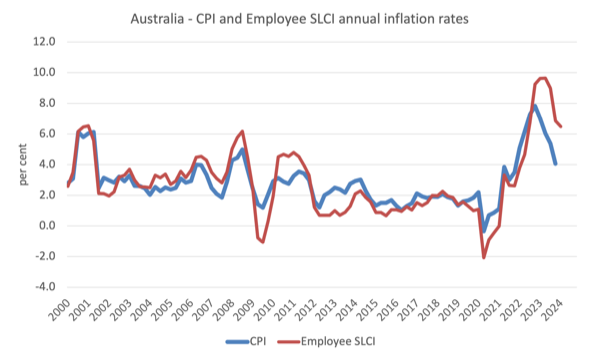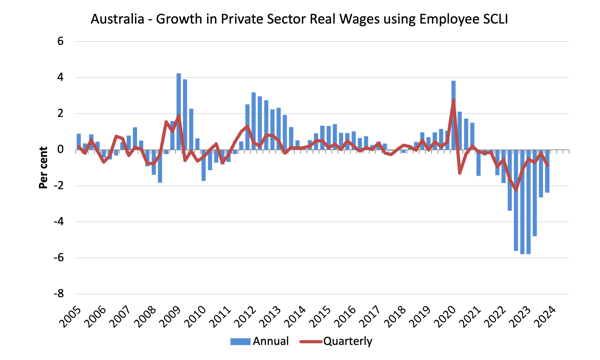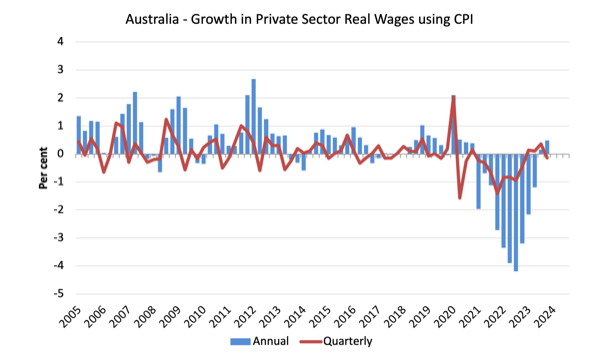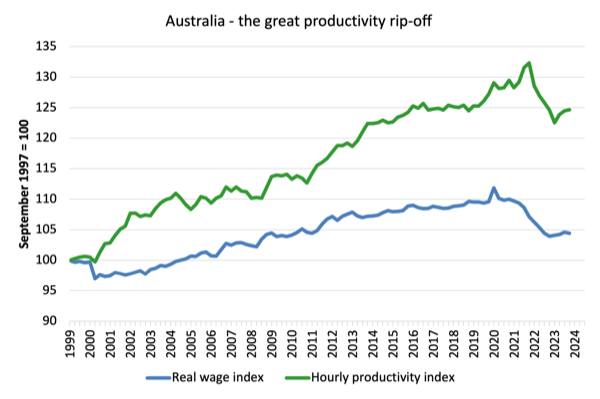[ad_1]
The Annual Fiscal Assertion for Australia (aka ‘The Finances’) got here out final night time and ordinarily I’d analyse it in the present day. However I’m travelling so much in the present day and likewise the wage information got here out in the present day, so I plan to go away the fiscal coverage commentary till subsequent week when I’ve extra time to consider the shifts in coverage. Right this moment (Might 15, 2023), the Australian Bureau of Statistics launched the newest – Wage Worth Index, Australia – for the March-quarter 2024, which exhibits that the mixture wage index rose by 4.1 per cent over the 12 months (down 0.1 level on the final quarter). In relation to the March-quarter CPI change (3.6 per cent), this outcome means that actual wages achieved modest good points. Nevertheless, if we use the extra applicable Worker Chosen Residing Price Index as our measure of the change in buying energy then the March-quarter results of 6.5 per cent signifies that actual wages fell by 2.4 per cent. Even the ABS notes the SLCI is a extra correct measure of cost-of-living will increase for particular teams of curiosity within the economic system. Nevertheless, most commentators will deal with the nominal wages progress relative to CPI actions, which in my opinion gives a deceptive estimate of the scenario employees are in. Additional, whereas productiveness progress is weak, the motion in actual wages is such that actual unit labour prices are nonetheless declining, which is equal to an ongoing attrition of the wages share in nationwide earnings. So firms are failing to take a position the huge income they’ve been incomes and are additionally taking benefit of the present scenario to push up revenue mark-ups. A system that then forces tens of hundreds of employees out of employment to cope with that drawback is void of any decency or rationale. That’s modern-day Australia.
Newest Australian information
The Wage Worth Index:
… measures adjustments within the worth of labour, unaffected by compositional shifts within the labour drive, hours labored or worker traits
Thus, it’s a cleaner measure of wage actions than say common weekly earnings which will be influenced by compositional shifts.
The abstract outcomes (seasonally adjusted) for the March-quarter 2023 had been:
| Measure | Quarterly (per cent) | Annual (per cent) |
| Personal hourly wages | 0.8 (-0.1 factors) | 4.1 (-0.1 level) |
| Public hourly wages | 0.5 (-0.8 factors) | 3.7 (-0.5 factors) |
| Complete hourly wages | 0.8 (-0.2 factors) | 4.1 (-0.1 level) |
| Worker Chosen Price-of-Residing measure | 1.7 (_0.6 factors) | 6.5 (-0.4 factors) |
| Primary CPI measure | 0.6 (-0.6 factors) | 3.6 (-1.2 factors) |
| Weighted median inflation | 1.1 (+0.2 factors) | 4.2 (-0.2 factors) |
| Trimmed imply inflation | 1.0 (+0.2 factors) | 4.4 (regular) |
On worth inflation measures, please learn my weblog put up – Inflation benign in Australia with loads of scope for fiscal enlargement (April 22, 2015) – for extra dialogue on the assorted measures of inflation that the RBA makes use of – CPI, weighted median and the trimmed imply. The latter two purpose to strip volatility out of the uncooked CPI sequence and provides a greater measure of underlying inflation.
The ABS press launch – Annual wages progress 4.1% in March quarter 2024 – notes that:
The Wage Worth Index (WPI) rose 0.8 per cent in March quarter 2024, and 4.1 per cent for the yr …
Annual wage progress within the personal sector was 4.1 per cent in March quarter 2024. This adopted a 4.2 per cent final result in December quarter 2023 and is greater than the three.8 per cent progress recorded this time final yr. That is the primary time that non-public sector annual wage progress has fallen since September quarter 2020.
… The WPI annual all sectors wage progress has remained at or above 4 per cent since September quarter 2023. The final time wages progress was at this stage for 3 consecutive quarters was March quarter 2009 …
Public sector annual wage progress was 3.8 per cent, decrease than the 4.3 per cent in December 2023, however greater than the identical interval final yr (3.0 per cent).
The quarter’s outcomes present a softening in nominal wages progress and a modest actual wage achieve utilizing the CPI determine.
Nevertheless, in saying that, we now have to think about what’s the most applicable cost-of-living measure to deploy.
Inflation and price of residing measures
There’s a debate as to which cost-of-living measure is essentially the most applicable.
Essentially the most used measure revealed by the Australian Bureau of Statistics (ABS) is the quarterly ‘All Teams Shopper Worth Index (CPI)’.
Reflecting the necessity to develop a measure of ‘the worth change of products and providers and its impact on residing bills of chosen family sorts’, the ABS started publishing a brand new sequence in June 2000 – the Analytical Residing Price Indexes – which turned a quarterly publication from the March-quarter 2009.
In its technical paper (revealed October 27, 2021) – Continuously requested questions (FAQs) in regards to the measurement of housing within the Shopper Worth Index (CPI) and Chosen Residing Price Indexes (SLCIs) – the ABS observe that:
The CPI and SLCIs are carefully associated. All these indexes measure adjustments in costs paid by the family sector (shoppers) for a basket of products and providers offered by different sectors of the economic system (e.g. Authorities, companies). The weights within the ‘basket’ characterize quantities of expenditure by households on items and providers purchased from different sectors. Items traded between households (like shopping for and promoting present homes) are excluded as each side of the transaction happen throughout the family sector.
I focus on these indexes intimately on this weblog put up – Australia – actual wages proceed to say no and wage actions present RBA logic to be a ruse (August 16, 2023).
In impact, the SLCIs characterize a extra dependable indicator of ‘the extent to which the impression of worth change varies throughout totally different teams of households within the Australian inhabitants’.
There are 4 separate SLCIs compiled by the ABS:
- Worker households.
- Age pensioner households.
- Different authorities switch recipient households.
- Self-funded retiree households
The newest information – Chosen Residing Price Indexes, Australia – was revealed by the ABS on Might 1, 2024 for the March-quarter 2024.
Between the March-quarter 2023 and the March-quarter 2024, the expansion within the respective SLCIs has been:
- Worker households: 6.5 per cent (-0.4 factors).
- Age pensioner households: 3.3 per cent (-1.4 factors).
- Different authorities switch recipient households: 4.4 per cent (-0.4 factors).
- Self-funded retiree households: 3.4 per cent (-0.6 factors).
The ‘All teams CPI’, in contrast, rose 3.6 per cent over the identical interval (as in above Desk).
The next graph exhibits the variations between the CPI-based measure and the Worker SLCI measure which higher displays the adjustments in cost-of-living.
Thus, when particular family expenditure patterns are extra rigorously modelled, the SLCI information reveals that the cost-of-living squeeze on ‘worker households’ is extra intense than is depicted by utilizing the generic CPI information.
The ABS considers the ‘Worker households SLCI’ to be its most well-liked measure designed to seize cost-of-living adjustments extra precisely for ‘households whose principal supply of earnings is from wages and salaries’.
The related cost-of-living measure for employees has risen by 6.5 per cent during the last yr whereas wages progress was simply 4.1 per cent – a lower in the true buying energy of wages of two.4 per cent.
When thought-about in opposition to the rise within the CPI (3.6 per cent), then the nominal wage progress of 4.1 per cent delivers an actual wage rise of 0.5 factors.
Actual wage tendencies in Australia
The abstract information within the desk above verify that the plight of wage earners continues in Australia.
The extent of the true wage decline during the last 12 months is determined by the cost-of-living measure used (see earlier graph for a comparability between the CPI measure and the Worker SLCI measure).
To additional reinforce that time, the next graphs use the Worker SLCI measure (first graph) and the CPI (second graph) to point out the motion of actual wages within the personal sector from 2005 to the March-quarter 2023.
By way of the SLCI measure, there was a dramatic drop in actual wages within the economic system during the last 12 quarters.
Staff within the personal and public sectors have each skilled sharp declines within the buying energy of their wages.
That is concurrently rates of interest are have risen extra rapidly than any time within the distant previous.
The fluctuation in mid-2020 is an outlier created by the non permanent authorities choice to supply free little one take care of the March-quarter which was rescinded within the March-quarter of that yr.
General, the file since 2013 has been appalling.
All through many of the interval since 2015, actual wages progress has been unfavourable aside from some partial catchup in 2018 and 2019.
The systematic actual wage cuts point out that wages haven’t been driving the inflationary episode.
Staff are solely in a position to safe partial offset for the cost-of-living pressures brought on by the supply-side, pushed inflation.
The second graph exhibits the true wage calculation utilizing the CPI because the deflator.
The scenario for employees is simply marginally higher given the CPI inflation price is decrease than the SLCI price.
The good productiveness rip-off continues
Whereas the decline in actual wages signifies that the speed of progress in nominal wages being outstripped by the inflation price, one other relationship that’s essential is the connection between actions in actual wages and productiveness.
The RBA is now making an enormous deal of the truth that wages progress is just too excessive relative to productiveness progress.
Traditionally (up till the Eighties), rising productiveness progress was shared out to employees within the type of enhancements in actual residing requirements.
In impact, productiveness progress gives the ‘area’ for nominal wages to progress with out selling cost-push inflationary pressures.
There may be additionally an fairness assemble that’s essential – if actual wages are retaining tempo with productiveness progress then the share of wages in nationwide earnings stays fixed.
Additional, greater charges of spending pushed by the true wages progress can underpin new exercise and jobs, which absorbs the employees misplaced to the productiveness progress elsewhere within the economic system.
The next graph exhibits the annual change (per cent) in Actual Unit Labour Prices from the March-quarter 1999 to the March-quarter 2024 utilizing the CPI measure to deflate nominal wages.
I used the CPI measure as a result of the RBA claims that’s what they deal with fairly than the SLCI, which is a measure of the price of residing.
Although productiveness progress has been weak or unfavourable not too long ago, RULCs have continued to fall, as a result of the true wage progress has been weaker than the productiveness progress (or within the present interval, the autumn in actual wages has outstripped the autumn in productiveness progress).
We will see that within the following graph which exhibits the full hourly charges of pay within the personal sector in actual phrases deflated with the CPI (blue line) and the true GDP per hour labored (from the nationwide accounts) (inexperienced line) from the March-quarter 1999 to the March-quarter 2023.
It doesn’t make a lot distinction which deflator is used to regulate the nominal hourly WPI sequence. Nor does it matter a lot if we used the nationwide accounts measure of wages.
However, over the time proven, the true hourly wage index has grown by solely 4.6 per cent (and falling sharply), whereas the hourly productiveness index has grown by 24 per cent.
So not solely has actual wages progress turned unfavourable over the 18 months or so, however the hole between actual wages progress and productiveness progress continues to widen.
If I began the index within the early Eighties, when the hole between the 2 actually began to open up, the hole could be a lot better. Knowledge discontinuities nonetheless stop a concise graph of this kind being offered at this stage.
For extra evaluation of why the hole represents a shift in nationwide earnings shares and why it issues, please learn the weblog put up – Australia – stagnant wages progress continues (August 17, 2016).
The place does the true earnings that the employees lose by being unable to achieve actual wages progress in keeping with productiveness progress go?
Reply: Largely to income.
These weblog posts clarify all this in additional technical phrases:
1. Puzzle: Has actual wages progress outstripped productiveness progress or not? – Half 1 (November 20, 2019).
2. Puzzle: Has actual wages progress outstripped productiveness progress or not? – Half 2 (November 21, 2019).
Conclusion
Within the March-quarter 2024, Australia’s nominal wage progress grew by 4.1 per cent.
Nevertheless, whereas inflation is falling it was nonetheless measured at 3.6 per cent, which signifies that actual wages grew during the last 12 months.
Whereas most commentators will deal with the nominal wages progress relative to CPI actions, the extra correct estimate of the cost-of-living change is the Worker Chosen Residing Price Index, which is working effectively above the CPI change – which means that actual buying energy of the nominal wages continues to be falling sharply.
Additional with the hole between productiveness progress and the declining actual wages growing, the huge redistribution of nationwide earnings away from wages to income continues.
That is no time for employees to rejoice the current wage rises.
That’s sufficient for in the present day!
(c) Copyright 2024 William Mitchell. All Rights Reserved.
[ad_2]




